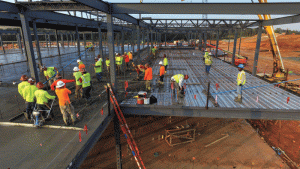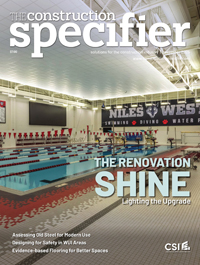Clearing specifiers’ misconceptions about lightweight concrete

However, lightweight concrete provided savings in other areas to produce a net cost which was 9.2 percent less than the normal-weight concrete design, which translates to over $435,000 saved. The greatest cost savings can be found in the footings. The use of lightweight concrete presented a 27 percent reduction in footing cost due to reduced structural load. Further, because lightweight concrete reduces the dead load due to its low density and thinner floor slab requirements, the steel framing cost was reduced by 10.5 percent. While the savings from these two areas greatly outweigh the increased material cost of the concrete and shear studs, it is important to note how the floor slabs required less labor to install, also providing enough savings to more than offset increased material cost.
Additionally, the study found the total floor weight for the lightweight concrete design was 18.3 percent lighter than normal-weight concrete, reducing the seismic mass and base shear by 23 and 21 percent, respectively. This contributed to additional savings in foundation costs.
To answer this question, lightweight concrete is more expensive than normal-weight concrete based on per cubic meter (cubic yard) costs alone. However, when the complete design of a building is considered, lightweight concrete drives economies that not only offset its higher initial cost but can lead to net savings in a building’s bottom line.
Heavy savings and benefits
Lightweight concrete can have comparable strengths and drying times as normal-weight concrete but with typically 25 to 35 percent of the weight. The reduced weight provides significant savings, as well as increased resilience to seismic activity. Further, the material can also provide longer spans and thinner slabs while satisfying requisite building safety codes. However, before choosing lightweight over normal-weight concrete, it is important for specifiers clearly know and communicate to the contractor all the details of the project, including if the required density is the plastic, estimated 28-day air dried, or the calculated equilibrium density as determined according to ASTM C567, Standard Test Method for Determining Density of Structural Lightweight Concrete, to ensure they choose the right material for the application.








